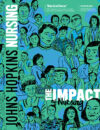By Helena Addison
When pain doesn’t show, doubting nurses should check themselves first
A young man with sickle cell disease presents to the Emergency Department reporting that his leg and back pain is a 9 on a 10-point scale. “Really?” The nurse responds in disbelief—he is not grimacing, sweating, or crying out in pain.
One of the first things nurses learn about pain is that it is “whatever the person experiencing it says it is.” Yet when individuals with sickle cell disease (SCD) report severe pain, they are frequently met with disbelief and their pain is often inadequately managed. Also, most individuals with SCD are black (though the disease can affect any race or ethnicity) and many report experiencing discrimination during such interactions. In fact, race-based discrimination for patients with this disease contributes to negative provider attitudes, longer emergency department (ED) wait times, insufficient treatment, and lack of research funding.
SCD describes a group of inherited blood disorders that often cause hard, sticky, and sickle or C-shaped red blood cells. It affects 90,000-100,000 Americans and millions globally. The most prevalent clinical complication of SCD is sickle cell crisis, an episode of severe, acute pain caused by occlusion of small blood vessels by the sickle-shaped cells. These account for approximately 230,000 ED visits and over $1.5 billion in health expenditures annually.
“In reality, patients with SCD are not more likely to misuse opioids.”
Over time, most patients with SCD have developed mechanisms to cope with severe pain that result in atypical, minimal, or non-existent objective displays of pain. That’s why it’s important to consider the psychosocial complexities of SCD—or any disease—when assessing pain. Otherwise the subtle influence of stigma and implicit bias related to race and the disease itself can creep into care.
Sixty-three percent of nurses incorrectly believe addiction is prevalent among patients with SCD. In reality, they are not more likely to misuse opioids than patients with other chronic painful conditions. SCD patients average two to three hospital visits a year. Each time, they become more familiar with what medications and doses work best. Unfortunately, requesting a specific medication and dose is considered a drug-seeking behavior. This stereotype contributes to delays in relief.
Guidelines published by the American Pain Society and the National Heart, Lung, and Blood Institute call for early and aggressive pharmacological treatment of sickle cell crises. But providers are increasingly reluctant to provide opioids given the abuse epidemic. This puts nurses in a tough spot, but we must check our biases and use our best judgment. We cannot let patients suffer in our care.
Nurses have a critical role in improving pain management and quality of life. When assessing pain, believe the patient. As we search for alternatives to opioids for treatment of moderate to severe pain and develop new policy and practice guidelines, it is imperative that we keep
in mind the unique needs of patients with SCD.
Helena Addison is a student in the MSN (Entry into Nursing) program.

